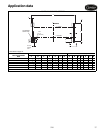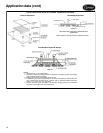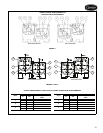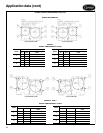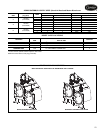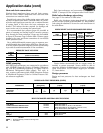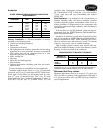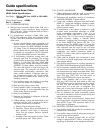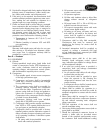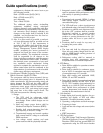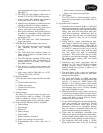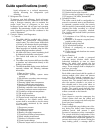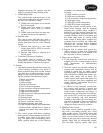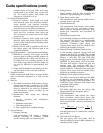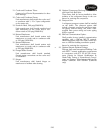
28
liquid refrigerant to a reduced temperature,
thereby increasing the refrigeration cycle
efficiency.
F. Refrigerant Flow Control:
To improve part load efficiency, liquid refrigerant
shall be metered from the condenser to the cooler
using a float-type metering valve to maintain the
proper liquid level of refrigerant in the heat
exchangers under both full and part load operating
conditions. By maintaining a liquid seal at the float
valve, bypassed hot gas from the condenser to the
cooler is eliminated.
G. Controls, Safeties, and Diagnostics:
1. Controls:
a. The chiller shall be provided with a factory-
installed and factory-wired microprocessor
control center. The control center shall include
a 16-line by 40-character liquid crystal display,
4 function keys, stop button, and alarm light.
Other languages are available using the inter-
national language translator software.
b. All chiller and motor control monitoring shall
be displayed at the chiller control panel.
c. The controls shall make use of non-volatile
memory.
d. The chiller control system shall have the ability
to interface and communicate directly to the
building control system.
e. The default standard display screen shall simul-
taneously indicate the following minimum
information:
1) Date and time of day
2) 24-character primary system status
message
3) 24-character secondary status message
4) Chiller operating hours
5) Entering chilled water temperature
6) Leaving chilled water temperature
7) Evaporator refrigerant temperature
8) Entering condenser water temperature
9) Leaving condenser water temperature
10) Condenser refrigerant temperature
11) Oil supply pressure
12) Oil sump temperature
13) Percent motor rated load amps (RLA)
f. In addition to the default screen, status
screens shall be accessible to view the status
of every point monitored by the control
center including:
1) Evaporator pressure
2) Condenser pressure
3) Compressor speed
4) Bearing oil supply temperature
5) Compressor discharge temperature
6) Motor winding temperature
7) Number of compressor starts
8) Control point settings
9) Discrete output status of various devices
10) Variable frequency drive status
11) Optional spare input channels
12) Line current and voltage for each phase
13) Frequency, kW, kWhr, demand kW
g. Schedule Function:
The chiller controls shall be configurable for
manual or automatic start-up and shutdown.
In automatic operation mode, the controls
shall be capable of automatically starting and
stopping the chiller according to a stored
user programmable occupancy schedule.
The controls shall include built-in provisions
for accepting:
1) A minimum of two 365-day occupancy
schedules.
2) Minimum of 8 separate occupied/unoc-
cupied periods per day
3) Daylight savings start/end
4) 18 user-defined holidays
5) Means of configuring an occupancy
timed override
6) Chiller start-up and shutdown via remote
contact closure
h. Service Function:
The controls shall provide a password
protected service function which allows
authorized individuals to view an alarm
history file which shall contain the last
25 alarm/alert messages with time and date
stamp. These messages shall be displayed in
text form, not codes.
i. Network Window Function:
Each chiller control panel shall be capable of
viewing multiple point values and statuses
from other like controls connected on a
common network, including controller main-
tenance data. The operator shall be able to
alter the remote controller’s set points or
time schedule and to force point values or
statuses for those points that are operator
forcible. The control panel shall also have
access to the alarm history file of all like con-
trollers connected on the network.
j. Pump Control:
Upon request to start the compressor, the
control system shall start the chilled and
condenser water pumps and shall verify that
flows have been established.
k. Ramp Loading:
A user-configurable ramp loading rate, effec-
tive during the chilled water temperature
pulldown period, shall prevent a rapid
increase in compressor power consumption.
The controls shall allow configuration of the
ramp loading rate in either degrees per min-
ute of chilled water temperature pulldown or
percent motor amps per minute. During the
ramp loading period, a message shall be
Guide specifications (cont)



